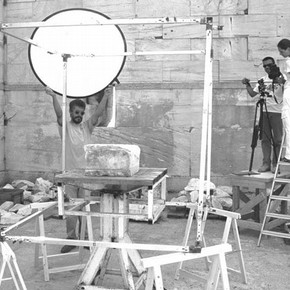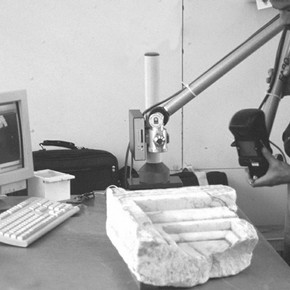Conservation Journal
Spring 2001 Issue 37
Digital Weightlifing and the Conservation of Large, Heavy Objects
Introduction
Few conservators would list weightlifting among their favourite sports or as an important area for professional development. The 'average' museum object is small and light enough for the 'average' conservator to manipulate. Hence the handling and treatment of most objects can be managed safely for both the conservator and the object without a well-developed physique and technical mastery of the snatch and jerk.
Unfortunately, on the archaeological sites of Ancient Greece (where the sport of weightlifting was first introduced), the demands on the conservator may indeed stretch to this Olympic pursuit. Architectural fragments can weigh hundreds of kilos and be of very complex shape. Manipulating such objects usually involves specialist equipment but a high level of manpower and manhandling is almost always involved. The transfer of a piece of cornice on the Acropolis, which weighed 170 kilos, involved seven people for half an hour over a distance of less than fifty metres. The risks of immediate physical injury to both object and staff are high and the potential for long term damage to the conservator is worrying.
Just as digital technology is providing alternative approaches in many areas of human endeavour, so it can make a contribution to safer and more efficient conservation practice. This article introduces a new digital approach to the reconstruction of fragmented objects. This will be especially useful where extremely large, heavy objects are involved but also where fragility - of object or human - is a serious concern.
The Problem
The reconstruction of architectural components from fragments is one of the commonest problems in conservation. This process may include, as a first step, the study, measurement and documentation of the available fragments. The key stage in the whole process, however, involves an interesting combination of human reasoning and intuition. Fragments are sorted, selected and tested against each other to see if they match in a sequential process which leads to reconstruction. This is a familiar process from our experience in putting together jigsaws. To develop a digital approach to the 'matching problem' to help us dealing with a puzzle involving massive, complex, 3-D and possibly deteriorated fragments, we need to explore this process a little more thoroughly.
Existing Methodology
The methodology conservators follow can be roughly outlined as follows:
a) All available fragments are gathered for a general view.
b) The fragments are grouped according to their properties (colour, texture, design, material, type of deterioration, size, etc).
c) A hierarchy of properties is established.
d) The conservator looks for fragments with specific properties which broadly identify their position within the whole object. Decisions are made based on the conservator's understanding of how the reconstructed object may look.
e) The conservator locates two potentially matching fragments from the group with the most assured location and physically tests them to see if they match.
f) If the fragments match then they are considered as a single fragment. Steps d to f are then repeated until the number of fragments equals one.
This 'jigsaw' methodology has drawbacks when used in the conservation of large and heavily fragmented objects, as all of the steps demand the physical manipulation of heavy components. However, by creating digital 3-D models of the fragments, digital manipulation is possible. This minimizes hazards and effort, as the real objects are not used after the digital record is made (until the decision has been made on the location of the fragments). The digital manipulation involves both commercial computer software and custom made programming algorithms which will make the matching of broken objects easier and quicker.
Proposed Methodology
-
Recording of the objects
Capturing the geometry of 3-D objects is a well-known procedure (using computer aided tomographers, tracing needles, laser scanning, photogrammetry etc). However, not all of these methods are suitable for conservation. Physical contact of the measuring devices with the object is often inadvisable and remote methods are, for this reason, preferred. In addition most ancient or historic objects are located in museum or archaeological sites so the recording equipment must be portable to allow capturing of objects on site. Under these conditions, photogrammetry and laser scanning are the most appropriate methods of recording three-dimensional surfaces.
Fryer3 defines photogrammetry as a method of measuring the size and determining the shape of objects after recording them as images on film (or other electronic media). Photogrammetry has been mainly used for the production of maps but it has, also, been used for recording smaller objects with the introduction of Close Range Photogrammetry, easily applicable to museum objects and monuments 1, 6 . Although, other methods demand direct measuring on the object, photogrammetry uses measurements taken from the medium the object was recorded on. This makes it a very flexible technique as it allows us to measure distant objects remotely (e.g. upper architectural components of buildings, figure 1).
Laser scanners on the other hand consist of a laser emitter, a video camera in a fixed position relative to the emitter and a supporting device. Part of the supporting device is fixed relative to the object. The other part, which holds the camera with the emitter, moves around it. The scanner is connected to a computer for the collection of the data through specialised software.
Although the idea existed shortly after lasers were discovered, only after 1985 were laser scanners used in the field of engineering and not until the last decade have projects involving laser scanning taken place in museums 2, 4, 5 .
The advantages of these technologies make them useful tools for the conservator. The necessary training in the use of such equipment and software is not too demanding. The output of the recording process is a digital computer file with a 3-D model of the object. These techniques allow for integration with many other computer applications. Unfortunately, the cost, at the moment, makes this technology accessible to a few industries or specialised companies only.
-
Construction of the models
The output files from both the scanner and photogrammetry are point clouds (dense groups of points in 3D space which describe the object). These can be easily transformed to surfaces (defining the model) by widely used commercial software. The 'weight' of the model is measured in the number of points. Indeed there are cases where the model is so 'heavy' that our ability to 'lift' them is limited by the computational power available. However, this problem is only temporary as new and faster computer systems are introduced almost daily and different ways of describing a 3D surface can be adopted, (significantly reducing the quantity of the data).
Hence, in virtual 3D space, our major obstacle in manipulating objects is not gravity, but the speed of the available computer and the way the software handles the data.
-
The automatic approach
Because of the extended study of ancient Greece architecture, there is much information which can help identifying fragments from a building. This is extremely helpful in solving the matching problem. A database of geometric forms and patterns can be constructed. Whenever these patterns are reported on the examined fragments, the automatic estimation of the original location and orientation of the fragment relative to the whole building is possible. The problem is then focused on how the computer can identify similar features on two given fragments. An approach through programming is necessary as, according to a recent survey by the author, there is no commercial software for assisting in the solution of this problem. The programme should take into account the available information and give suggestions about the position and orientation of each fragment.
After two possibly matching pieces are found, a mechanism of assessing the match must be used. This will be based on the actual shape of the fracture surface. The fragments are brought close together in virtual space and the area of the match is measured. A tolerance value must be introduced in cases when the surface is deteriorated.
-
The manual approach
Given the complexity of the problem, an automatic methodology for solving it, may not be achievable in the short term. Nonetheless, a manual approach, which mimics the real world process in virtual space, will be achievable. This will involve the virtual manipulation of the fragments in 3D space, either in front of a computer screen or in a virtual reality environment, by the user. No automatic characterisation of the fragments will be available and the only criteria for the matching will be the experience of the user.
Quick conclusions.
Automatic, manual and semi-automatic approaches are currently being explored. Even if, in the short term, only the manual approach is developed to a functional level, this will allow conservators of archaeological monuments to deal with the 'matching problem' more safely and efficiently. It is difficult to assess the rate at which the automatic approach can be developed to a useable stage. However, once available, it will be immensely useful in the conservation of any fragmented object, not just those of unreasonable weight.
It is also worth emphasizing that, despite the cost of the equipment and software necessary for the capturing of the objects, the final record produced by the mixture of photogrammetry and laser scanning is the best available documentation for museum objects at the moment. It provides a 3D digital description of the object along with a set of photographs with information about the colour and the surface of the object.
Of course, some conservators will always prefer to lift weights and drive cranes.
Acknowledgements:
Many sincere thanks to doctor John Harrison for his unlimited support and patience. The author would, also, like to thank the State Scholarship Foundation of Greece for the financial support throughout this research.
References
1. Accardo G., et al. An Experimental Correlation Between Factors for Evaluation of Damage and the Monument's Geometry: The Case of the Roman Theatre at Aosta, 4th International Symposium on the Conservation of Monuments in the Mediterranean., May 1997, vol. 2.
2. Boulanger P., et al, Automatic replication and recording of museum artefacts, Analysis and examination of an art object by imaging technique, Tokyo National Research Institute of Cultural Properties, 1988
3. Fryer J.G., Close Range Photogrammetry and Machine Vision, Atkinson K.B (ed.)., 1996, Introduction p. 1-6.
4. Larson J., New approaches to the conservation of external stone sculpture: the twelfth century frieze at Lincoln Cathedral, Proceedings of the 7th International Congress on Deterioration and Conservation of Stone: Lisbon, Portugal, 1992 p. 1167-1175
5. Levoy M., The Digital Michelangelo Project, Second International Conference on 3D Digital Imaging and Modelling, Ottawa, Canada, October 1999.
6. Milella N., et al, Study of Structural Interventions and Changes Affected Altamura Cathedral (XII Century) by Means of Digital Photogrammetric Techniques, 4th International Symposium on the Conservation of Monuments in the Mediterranean., 6-11 May 1997, vol. 2.
Spring 2001 Issue 37
- Editorial - Size Matters
- The Treatment of Mail on an Arm Guard from the Armoury of the Shah Shuja: Ethical Repair and in situ Documentation in Miniature
- Management of Large Objects at the Science Museum, Wroughton
- Digital Weightlifing and the Conservation of Large, Heavy Objects
- Four Terabytes and Counting
- Colour Changes for the V&A Facade
- Review of 'Gilding: Approaches to Treatment' UKIC Gilding Section Conference

